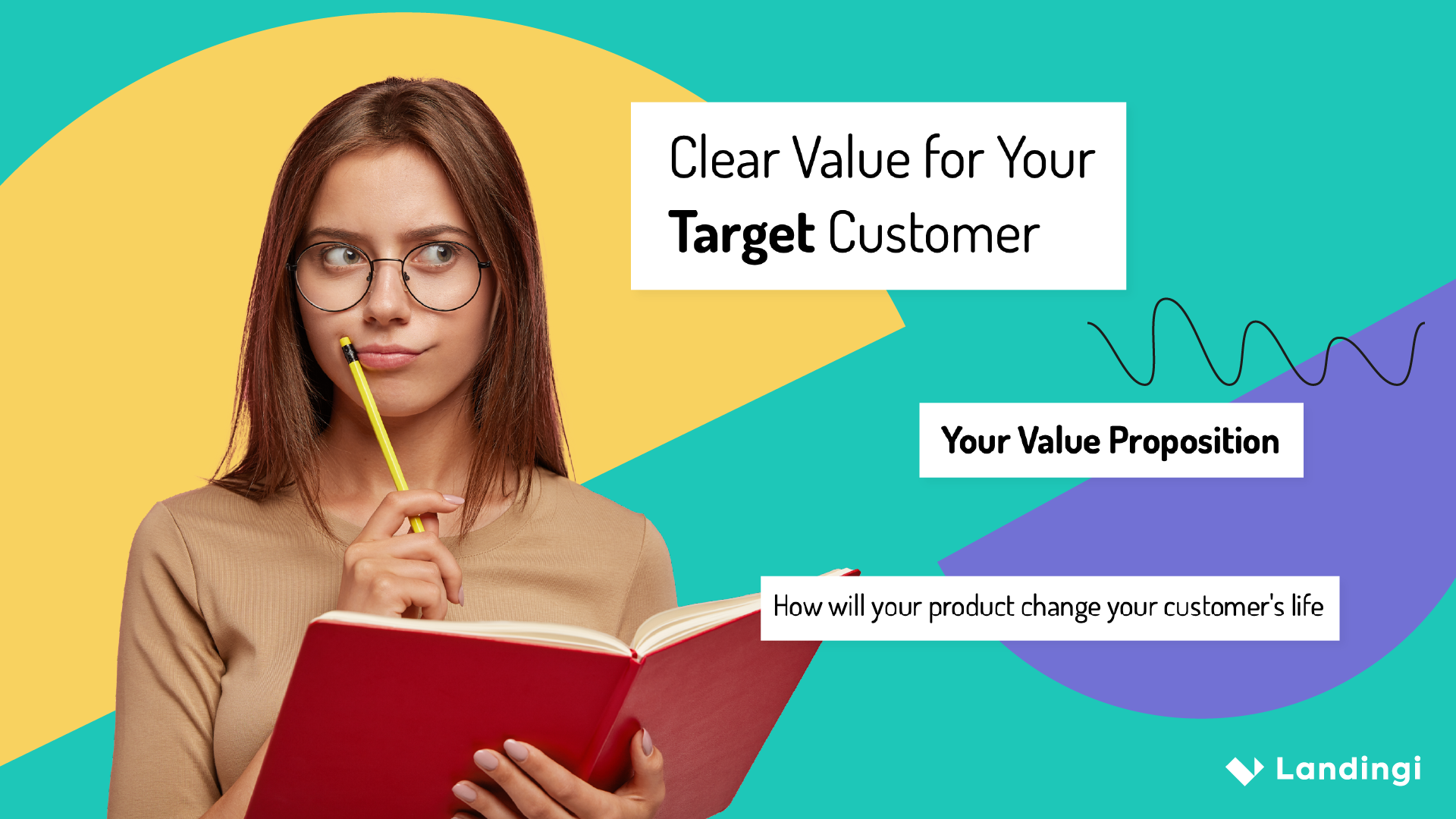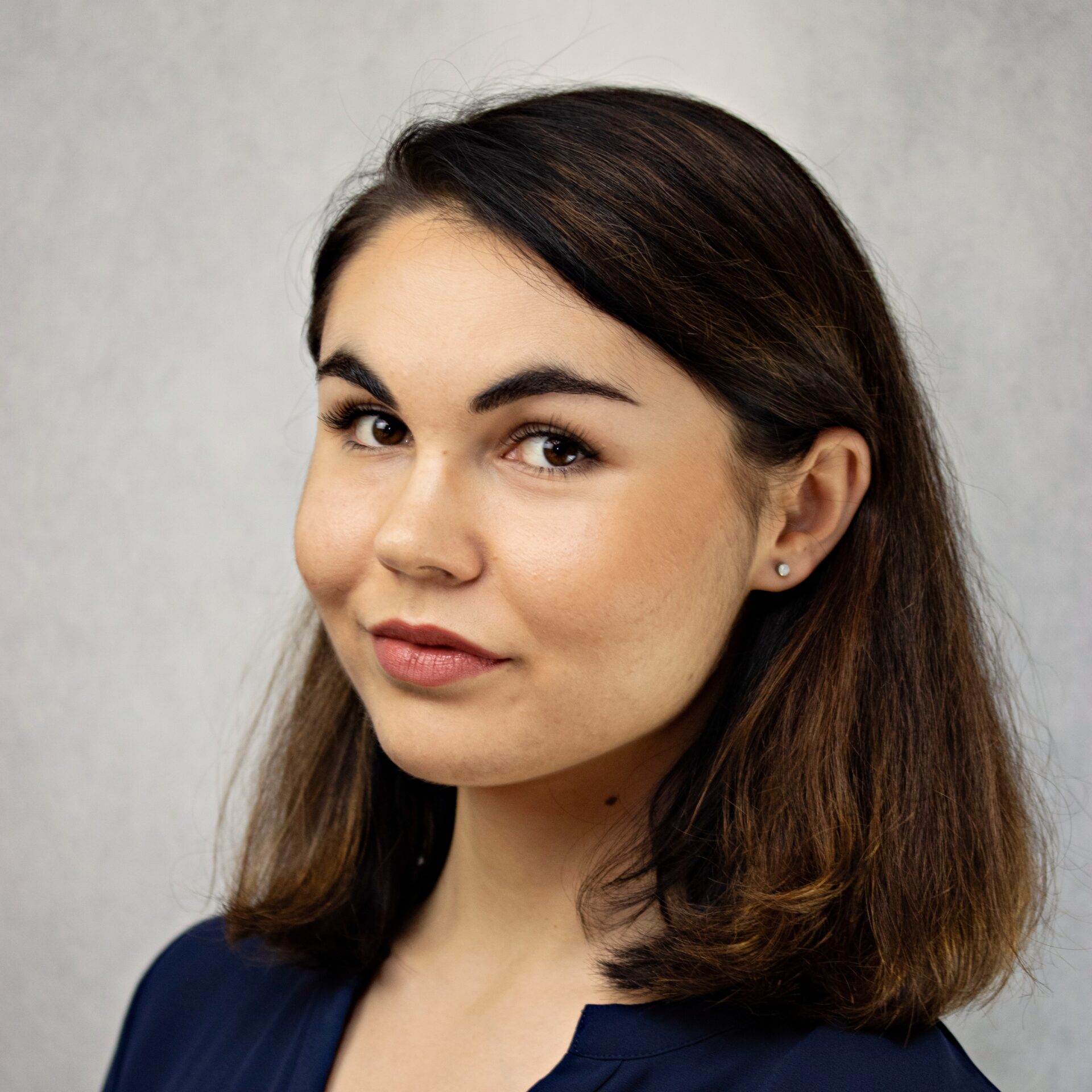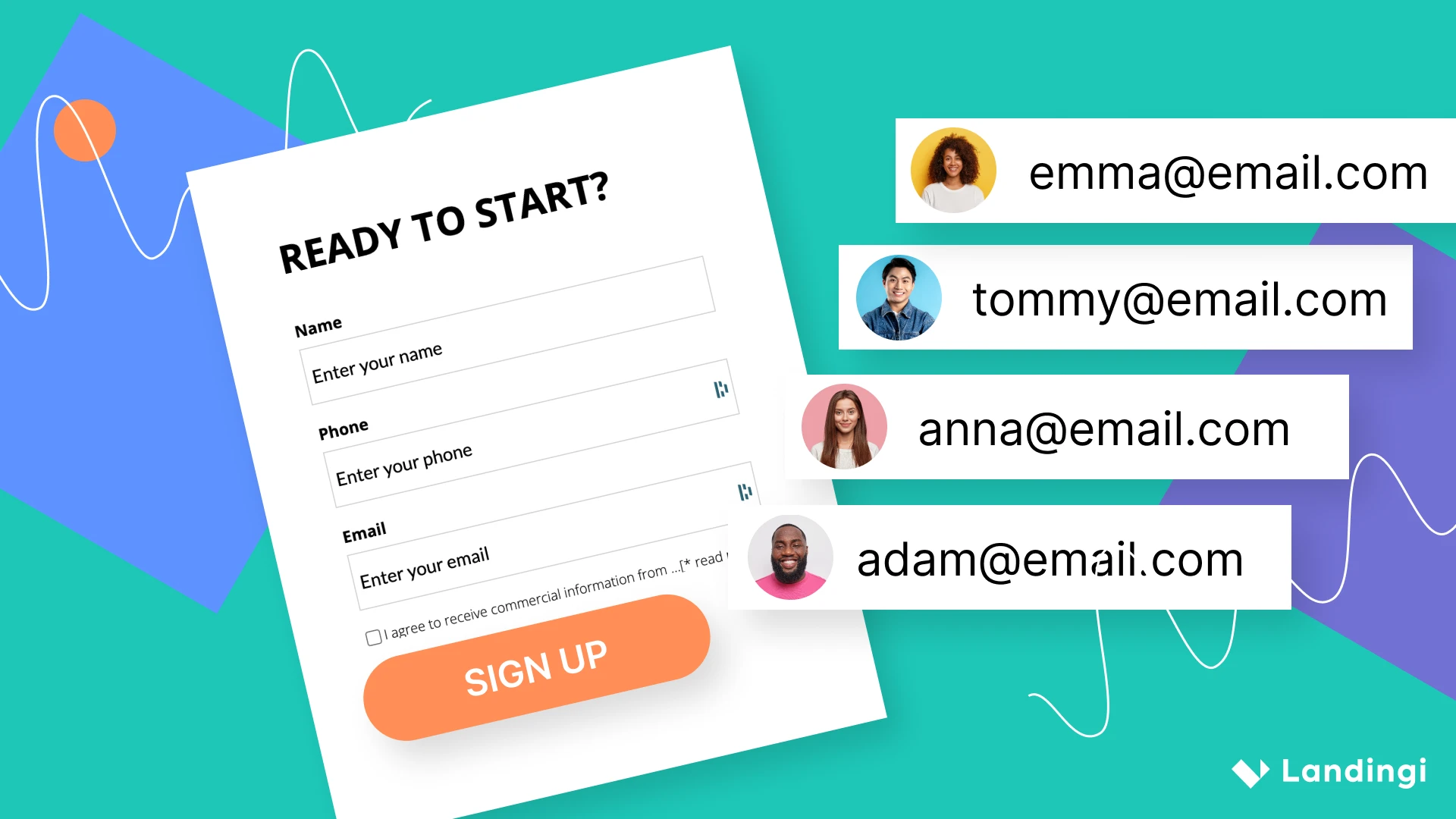If you’re seeking to convert browsing into buying, conversion copywriting is where you start. It allows you to craft messages that persuade readers to take a specific action, such as purchasing or signing up. This article distills down to the essentials – offering you a dozen proven tips and 9 real-life examples to achieve impactful copywriting that can assist you in realizing your conversion optimization goals.
As Jakob Nielsen reports, most readers only read up to 28% of the content on a page. Therefore, it is crucial to carefully consider every word and optimize it to ensure that no opportunity is missed to persuade the visitor regarding your offer. Optimizing your copywriting for conversion is absolutely essential for achieving success in today’s digital landscape. For example, personalized CTAs convert a whopping 202% better than generic ones (according to HubSpot). This presents a huge opportunity for improvement and growth, and by focusing on key areas, you can confidently take your copywriting to the next level and achieve the results you desire.
If you came here specifically for guidelines, here’s a list of 12 conversion copywriting tips that will improve your writing significantly:
- Know your audience
- Highlight benefits
- Use strong headlines
- Engage with compelling CTAs
- Be concise
- Emphasize action
- Create urgency
- Keep it specific
- Add social proof
- Simplify sentences
- Test different versions
- Use a conversational tone
Keep reading to learn the details and find some excellent conversion copywriting examples that can help you understand the concept better.
Make your sections smartable and let go of mundane manual tasks with Smart Sections! An easy way to manage bulk changes.
What Is Conversion Copywriting?
Conversion copywriting is crafting compelling content that informs individuals about the advantages of a product or service as it pertains to their needs. This approach goes beyond mere information delivery; it’s about resonating with readers on a deeper level.
From sales pages to landing pages, CRO copywriting takes on many forms, all with one goal – to persuade readers to take action.
The process of conversion copywriting involves a series of stages, including:
- Research
- Synthesis
- Strategy
- Writing
- Wireframing
- Editing
Each stage contributes to the creation of high-converting copy. By leveraging personalization and segmentation, conversion copywriting creates tailored copy variations that cater to specific customer groups, enhancing the likelihood of conversion.
How Do You Write Copy That Converts?
To write copy that captures your audience’s attention and drives conversion, understand their needs, wants, and pain points. Once you have a clear understanding of your audience, you can focus on showcasing the benefits of your product or service, rather than just listing its features. By demonstrating the value proposition, you can show how your product or service can enhance the reader’s life and provide a meaningful solution to their problems.
The use of strong headlines plays a crucial role in capturing attention and setting the context for the content that follows. Finally, the effectiveness of a call to action (CTA) relies on the use of emotive verbs, relevance to the reader’s interests, and a conclusion that addresses the reader’s needs.
How Do You Write a High-Converting Website Copy?
To write a high-converting website copy, ensure all content pieces fit together cohesively. Utilize the AIDCA framework to guide prospective customers through five key stages:
- Attention
- Interest
- Desire
- Conviction
- Action
This framework sustains their interest and nudges them towards a conversion. It is similar to the AIDA copywriting formula but the distinct difference is the conviction part. It is essential, because – according to Luciano Viterale’s “The AIDCA Copywriting Method Explained” – copywriting should focus on reducing the reader’s risk and reassuring them that they are making the right decision.
Strong calls-to-actions hold the same level of importance. They provide clear choices for immediate engagement and direct users towards taking the desired action. Adding a layer of trust and confidence to your copy are social proofs and statistics. Showcasing logos of reputable clients or incorporating statistics in the content assures prospective customers of your product’s reliability.
Finally, clear and focused messaging is key to ensuring a quick understanding of the offer, as it directly showcases product capabilities in a concise yet informative manner.
12 Tips to Conversion Copywriting
With a solid grasp of the fundamentals of conversion copywriting, let’s delve into some actionable tips to elevate your conversion copywriting game. These 12 points are designed to enhance your copy’s persuasiveness and, in turn, increase your conversion rates. To achieve this, you need to know your audience, highlight benefits, use strong headlines, engage with compelling CTAs, be concise, emphasize action, create urgency, keep it specific, add social proof, simplify sentences, test different versions, and use a conversational tone.
Implementing these tips will help you create more effective and persuasive copy that drives conversions. These principles can be applied to various content types, including landing pages, newsletters, e-books, blog content, etc.
1. Know Who Your Audience Is
Understanding your audience serves as the initial step in developing persuasive copy. Understanding your recipients’ needs, wants, and pain points allows you to tailor your texts to resonate with them. Developing documented customer personas is a crucial step in this process. It gives you clarity on the specific audience you are targeting and helps make your copy more engaging.
Research plays a significant role in this process by:
- Creating a cheat sheet of essential elements to include in your messaging
- Determining the message’s subject and delivery approach
- Minimizing the effort, time, and frustration associated with non-converting copy
To ensure that your content addresses the relevant points, it is advisable to seek feedback on the copy and value propositions from ideal customers.
2. Highlight Benefits
In conversion copywriting, highlighting benefits forms part of a tactical approach that involves:
- Emphasizing the advantages and positive outcomes that customers will derive from using a product or service, rather than solely listing its features
- Attracting and connecting with the target audience
- Underlining the unique selling proposition
- Contributing to increasing the overall effectiveness of the copy
To effectively highlight the benefits of a product or service, it is important to prioritize customer benefits over product features. This means aligning the product with specific desirable outcomes that the audience values. Speaking directly to the audience’s needs and concerns can also help in highlighting the benefits effectively. Using structured content outlines like AIDA can be a useful strategy to follow.
3. Use Strong Headlines
An enticing headline is characterized by:
- High level of specificity
- Emphasis on the value proposition
- Presentation of a clear benefit or reward to the reader
- Conciseness, typically consisting of 5 to 9 words (according to Kevan Lee from Buffer, the ideal length of a headline is 6 words)
A strong header acts as the initial step towards grabbing your reader’s interest.
Effective headlines like “kiss and makeup”, “read between the lines”, and “all that glitters isn’t gold” are not only eye-catching but also provide a context for the subsequent content and provide a reason for the reader to continue reading.
4. Use Engaging CTAs
A call to action (CTA) is a clear and direct incitement for the reader to perform a certain action. A compelling CTA is brief, utilizes powerful verbs, incorporates emotionally charged or enthusiastic language, emphasizes value, and strives for specificity. Phrases such as Get Started Now, Unlock Exclusive Content, Join Our Community, Limited Time Offer, and Download Now are strategically crafted to prompt immediate action, provide value, and appeal to the desire for connection, exclusivity, or urgency.
Thoughtfully designed CTAs and conversion copy have the potential to direct visitors towards the intended action, potentially boosting click-through rates by up to 42% and conversion rates by up to 121% (The importance of having a clear call-to-action on your landing page, Jimit Mehta, 2023).

5. Be Concise
The art of conciseness in copywriting involves:
- Conveying your message in a brief and to-the-point manner
- Avoiding superfluous words and unnecessary information
- Facilitating quicker decision-making for readers
- Enabling them to find the information they seek more efficiently
- Engaging the audience
- Boosting conversions
- Minimizing confusion about the product
- Capturing attention
- Delivering a clear message
- Facilitating reader comprehension and action
When writing a blog post, it is important to ensure that your copy is both effective and concise. One technique that can help with this is using the “reverse outlining” technique. After writing your initial draft, create an outline based on what you’ve written. This helps you see the main points and structure of your content more clearly. As you review the outline, identify and remove any redundant or off-topic sections. This process ensures that each part of your post is focused and contributes directly to your overall message, enhancing the conciseness and coherence of your writing.
A conversion copywriter should adhere to the principle of “one page, one message.” This means that each page should have a clear and distinct message that is easy to understand and remember.
6. Emphasize Action
Highlighting action in your copy serves as a roadmap leading the reader towards a conversion. It involves using persuasive language to prompt the reader to take a specific action, such as:
- Making a purchase
- Subscribing to a service
- Signing up for a newsletter
- Downloading a free resource
Emphasizing action has the potential to improve conversion rates by creating a sense of urgency and scarcity, which can effectively motivate people to act faster.
Incorporating active verbs in copywriting is an effective way to achieve conversion rate optimization. It maintains reader engagement, prompts action, and enhances conversions.
7. Create Urgency
Instilling a sense of urgency is an effective strategy to convince readers to take swift actions. This is often achieved through FOMO (Fear of Missing Out) marketing. By implying that the product or service being offered may not be available for long, FOMO marketing instills a sense of urgency and encourages swift response from the audience.
For instance, Nectar Sleep utilizes a countdown timer during its Memorial Day sale, creating a sense of urgency for customers to make a purchase before the sale concludes. However, it’s important to use FOMO tactics in a limited and authentic manner to avoid alienating consumers.
8. Keep It Specific
Ensuring specificity in your copy means:
- Tailoring a message that resonates with the audience
- Encouraging them to take a precise action, such as completing a purchase
- Providing concrete and detailed information that resonates with the audience
- Boosting credibility
- Making the copy more memorable
To enhance the effectiveness of conversion copywriting, it’s recommended to use specific language, address particular pain points, incorporate numbers and statistics, use specific calls to action, and feature relevant examples and testimonials. These techniques can help to increase the specificity of your messaging and improve the chances of converting leads into customers.
9. Add Social Proof
In CRO copywriting, social proof acts as a formidable instrument. It involves showcasing positive experiences or endorsements from others to establish trust and credibility with potential customers. Various forms of social proof include:
- Customer testimonials
- Expert endorsements
- Celebrity endorsements
- User-generated content
- Influencer marketing
- Live and recent activity displays
- Live visitor notifications
- Conversion notifications
- Purchase notifications
- Counter notifications
- Certifications
- Business credentials
10. Simplify Your Sentences
Simplicity is indeed the ultimate sophistication, a philosophy equally applicable to effective copywriting. Simplifying sentences helps to reduce cognitive load, utilize connotations effectively, and enhance the overall readability of your copy. Simple sentence structures can enhance clarity and readability, potentially leading to improved conversion results.
To simplify your sentences, you can:
- Keep your copy concise with short sentences and clear language
- Eliminate unnecessary words
- Use active voice
- Avoid adverbs
- Employ simple structures like bullet points and brief paragraphs
- Write words effectively by choosing the right vocabulary
11. Test Different Versions of Your Copy
Testing different versions of your texts is an important aspect of conversion copywriting. In the article “The ROI of Email Marketing”, Megan Moller states that companies that perform A/B testing on every email see 37% higher returns on email marketing than those that never conduct split tests. This demonstrates how conducting tests and using results to make adjustments can have a positive impact on outcomes.
Experimenting helps mitigate ad fatigue and enhances overall ad performance. A/B testing involves testing various versions of copy, headlines, and other elements to identify the most impactful ones in boosting conversions. To implement split testing principles, begin with a hypothesis, test one variable at a time, utilize a significant sample size, conduct the test for a suitable duration, analyze the results, and then iterate and optimize.
Platforms such as Landingi, VWO, or Optimizely are great examples of A/B testing tools.
12. Use Conversational Tone
The tone of your copy has a substantial impact on the reader’s interpretation of your message. Using a conversational tone helps establish a connection with the audience and enhances credibility.
A conversational tone makes your copy feel more personal and relatable, thus improving the overall customer experience and boosting conversion rates. To achieve an authentic and natural tone in your writing, it is helpful to read your content out loud. This can help you identify any parts that sound unnatural, allowing you to adjust them to maintain a conversational tone.
Conversion Copywriting: 9 Examples
Understanding the art of content creation requires both theory and practical application. To truly master this craft, it’s beneficial to study real-life conversion copywriting examples that have effectively persuaded audiences to take desired actions. In this section, we’ll take a closer look at nine exceptional examples of persuasive copywriting. They will not only help you understand the principles in action but also inspire you to create compelling copy that converts.
1. Sundose
Sundose’s home page employs persuasive marketing language to encourage website visitors to engage with their personalized supplement products. The site’s opening statement, “Your Personalised Supplement. Accurate. Easy. Better,” immediately establishes the core value proposition: custom-made nutrient mixes tailored to individual health and lifestyle needs. This message is reinforced by the claim of continuous improvement with each sachet, emphasizing personalization and evolution in line with the user’s changing requirements.
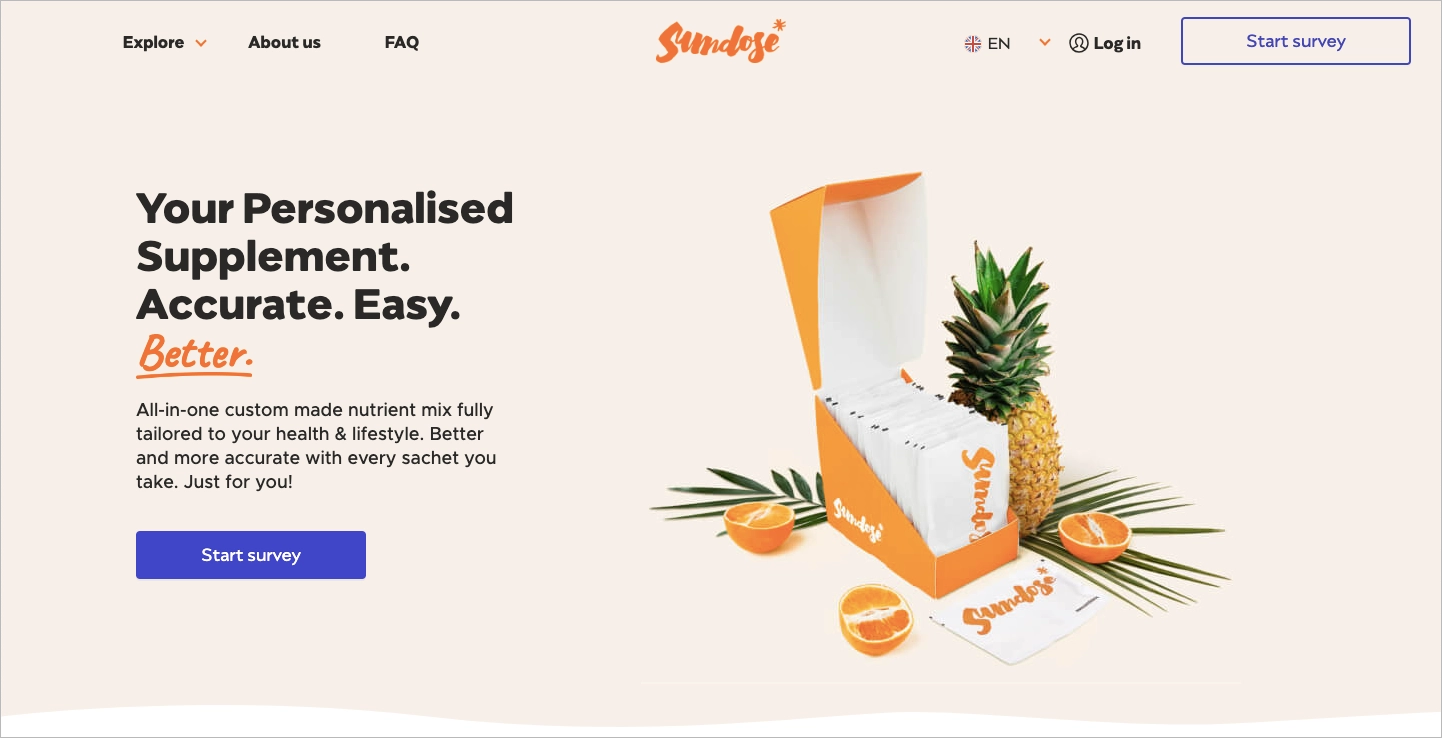
The website’s copy is structured around a four-step process, each step beginning with the phrase “Our Personalisation Starts From You.” This repetition not only reinforces the brand’s commitment to customization but also creates a sense of involvement and empowerment for the customer. The steps – discovering personal needs through a health assessment, defining health goals, relaxing while the product is blended and delivered, and optimizing the supplement monthly – are presented in a way that simplifies the process while highlighting the bespoke nature of the service.
The inclusion of free consultations with a dietitian adds an element of professional guidance, enhancing the perceived value of the service.
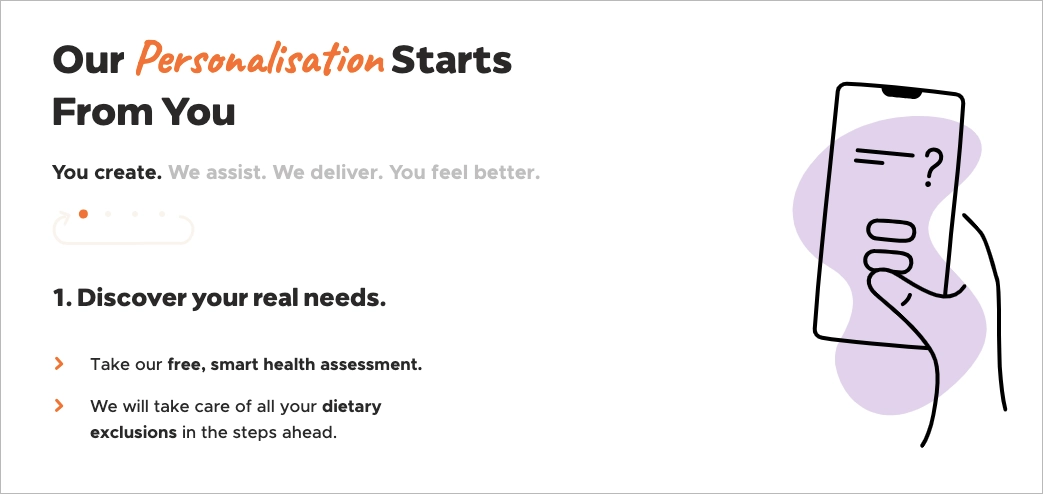
Sundose effectively demonstrates the real-world impact of its products through testimonials and case studies, showcasing the wide applicability and effectiveness of the supplements. This builds trust with potential customers and makes the benefits more tangible.
2. Evernote
The copy, “Tame your work, organize your life,” succinctly encapsulates the core benefit of Evernote – bringing order and efficiency to both professional and personal realms. This message is reinforced by the CTA “Sign up for free,” which lowers the barrier to entry, inviting users to experience Evernote’s value without immediate financial commitment.
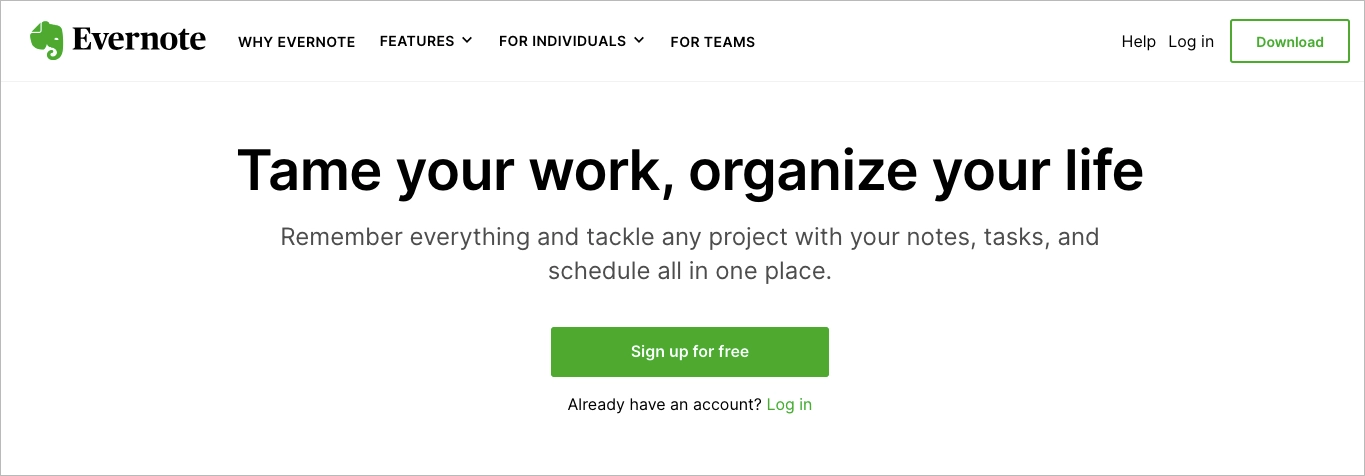
The website’s content further delves into Evernote’s features, emphasizing its versatility and ease of use. Phrases like “Work Anywhere,” “Remember Everything,” “Turn To-Do into Done,” and “Find Things Fast” are not just catchy; they directly address common pain points of the target audience. Each feature is explained in a way that highlights its practicality and impact on productivity. For instance, the ability to sync notes across devices under “Work Anywhere” speaks to the modern need for accessibility and flexibility in work environments.
The persuasive copy here is designed to resonate with the user’s daily challenges, making Evernote appear as an essential tool for managing tasks and information.

Evernote’s website offers educational content beyond just feature listing. Sections like “Find your productivity happy place” and “See what’s possible with Evernote” provide context and scenarios for using the product. This approach demonstrates the application’s versatility and helps users envision how Evernote can fit into and enhance their workflow. Direct CTAs like “Learn More” linked to detailed explanations of features ensure users are engaged and guided towards realizing the full potential of Evernote.
3. Mailchimp
Mailchimp’s website showcases persuasive marketing language, adeptly crafted to enhance customer engagement and drive sales. The opening statement, “Turn Emails into Revenue,” is a powerful example of their persuasive messaging strategy. This phrase succinctly encapsulates the core benefit of their service, appealing directly to businesses’ desire to increase revenue through effective email marketing. The use of the term “revenue” instead of a more generic term like “results” or “success” is a strategic choice, emphasizing the tangible financial gains that Mailchimp promises.
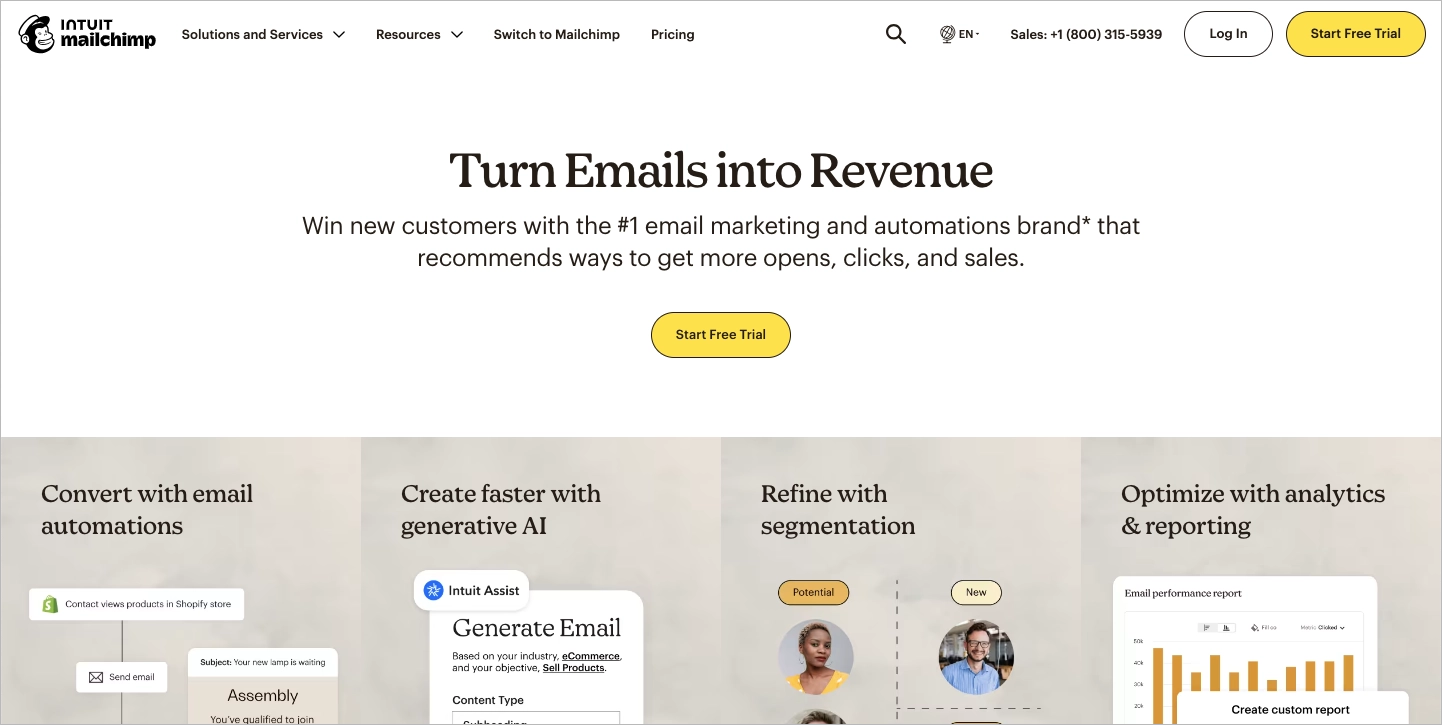
Further down, Mailchimp employs targeted language to address specific customer needs and pain points. Phrases like “Convert with email automations” and “Boost orders and customer lifetime value” demonstrate a deep understanding of their audience’s desires for efficiency and effectiveness in marketing. The language used effectively links the features of the service, including AI-powered automations, to the benefits for customers, such as increased orders and customer value.
Lastly, Mailchimp’s copywriting excels in creating a sense of ease and accessibility. Statements like “Effortlessly create on-brand content with generative AI tools” and “Refine with segmentation” reduce the perceived complexity of email marketing, making their platform appear user-friendly and approachable. This is particularly effective for attracting customers who may be intimidated by the intricacies of digital marketing.

By promising simplicity and ease of use, Mailchimp positions itself as a solution that is accessible to a wide range of users, from small business owners to larger enterprises. This inclusive approach is a key element of their persuasive strategy, broadening their appeal and potentially increasing their customer base.
4. Pinterest
Pinterest’s homepage showcases a blend of persuasive copywriting and visual storytelling, effectively engaging visitors and guiding them towards conversion. The opening line, “Get your next weeknight dinner idea, home decor idea, new look outfit, green thumb idea,” immediately addresses a diverse range of interests, suggesting that Pinterest is a versatile platform catering to various needs. This approach is inclusive and inviting, making it easy for visitors to see the value of exploring the site further. The copy is concise yet evocative, painting a picture of the endless possibilities that Pinterest offers.
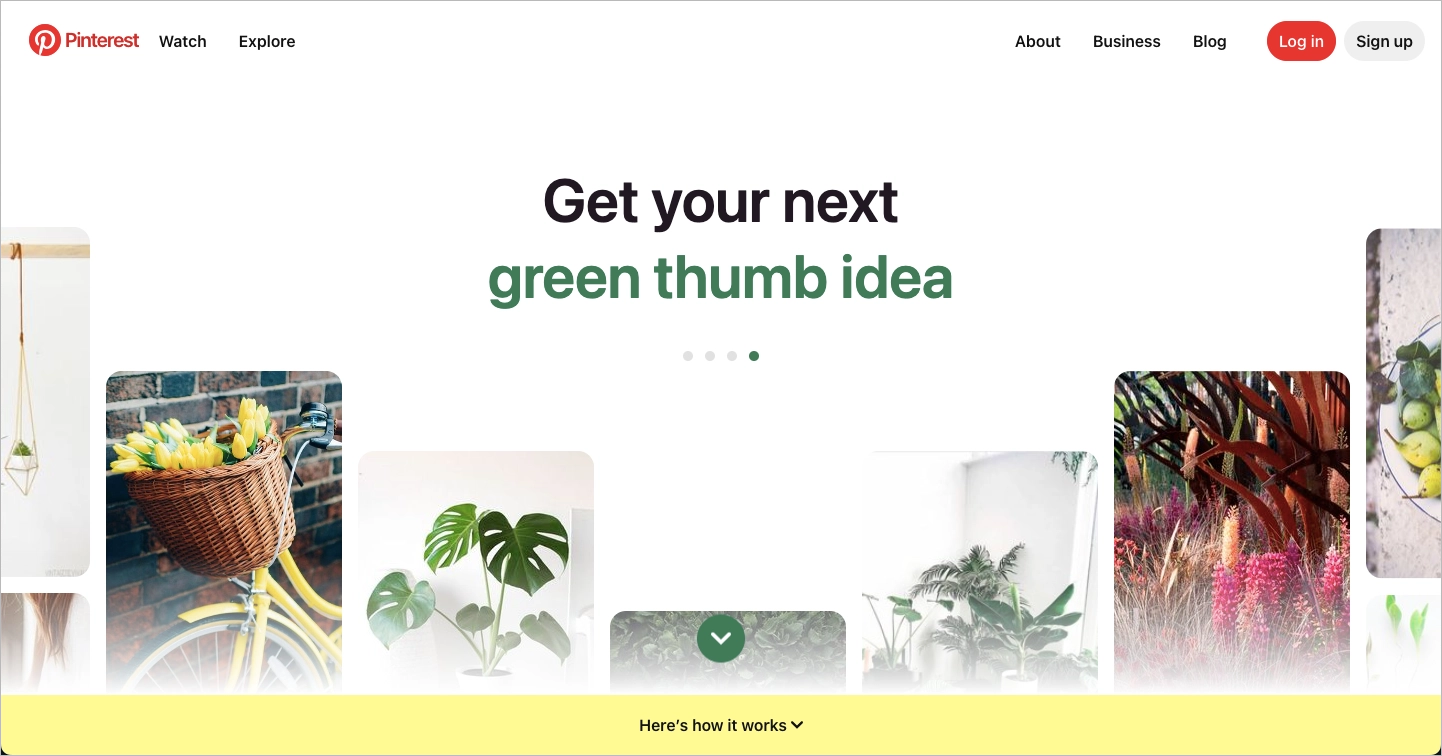
The website’s copy excels in creating a sense of ease and accessibility. Phrases like “Here’s how it works,” followed by simple, direct instructions, demystify the process of using Pinterest. This clarity is crucial in conversion copywriting, as it reduces any potential confusion or hesitation a new user might have. The copy “See it, make it, try it, do it” encapsulates the active, hands-on experience Pinterest promotes. This action-oriented language is persuasive, encouraging users not only to browse but also engage and create.
Finally, Pinterest’s copywriting fosters a sense of community and discovery. “The best part of Pinterest is discovering new things and ideas from people around the world,” highlights the global and communal aspect of the platform. It’s not just a tool for individual exploration but a gateway to a world of shared creativity and inspiration. This aspect of the copy appeals to the human desire for connection and learning, making it an effective tool in persuading users to sign up and become part of the Pinterest community.
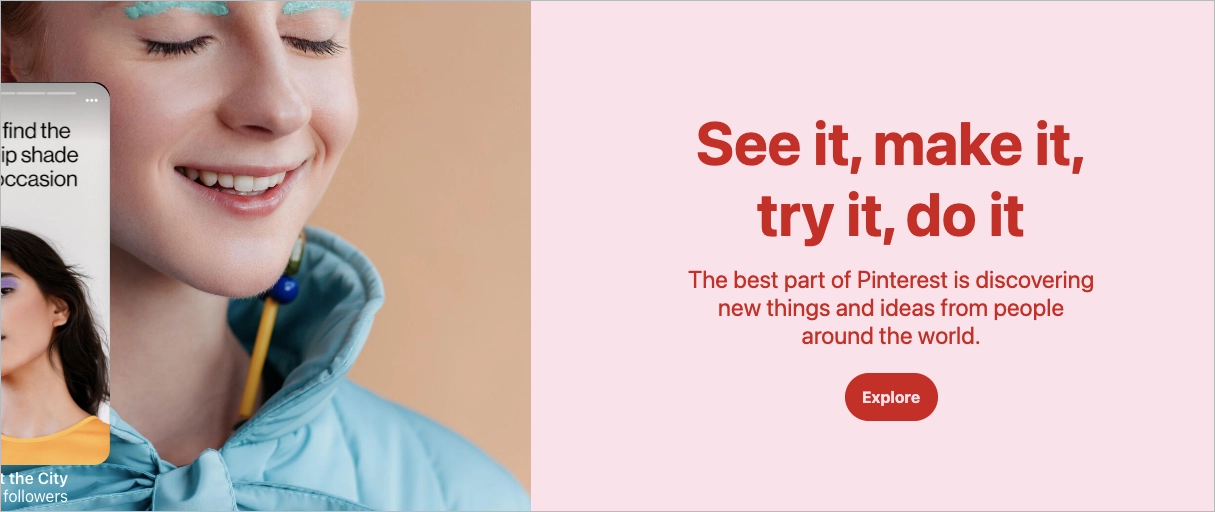
Pinterest’s copywriting is a well-crafted blend of inclusivity, clarity, action, and community, effectively drawing in and engaging its audience.
5. Slack
The copywriting on Slack’s website is a well-crafted blend of persuasive and informative elements, designed to engage and convert visitors into users. The overarching theme is Slack’s positioning as a productivity platform, emphasizing its superiority over traditional communication methods like email. This is evident in the tagline “Made for people. Built for productivity,” which succinctly encapsulates the platform’s user-centric design and productivity-enhancing features.
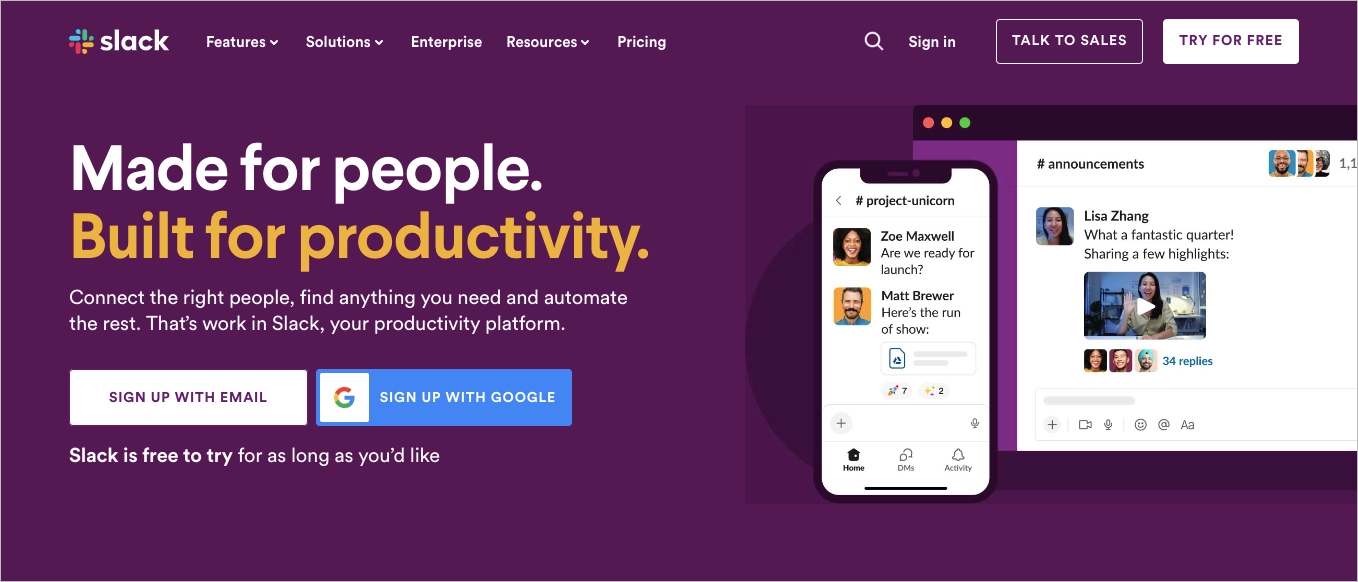
The website’s content strategically highlights Slack’s key benefits and features, using a mix of direct and indirect approaches to persuade potential users. For instance, phrases like “Connect the right people, find anything you need and automate the rest” and “Move faster with your tools in one place” succinctly convey the platform’s ability to streamline communication and integrate various tools, enhancing overall efficiency. This is further reinforced by the mention of generative AI, indicating Slack’s commitment to cutting-edge technology.
The copy also addresses potential user concerns about flexibility and collaboration, with statements like “Choose how you want to work” and “Bring your team together,” which emphasize Slack’s adaptability and its role in fostering team cohesion.

Moreover, the website leverages social proof and authority by showcasing endorsements from large, trusted companies and including positive statistics about user experiences. For example, the mention of “85% of users say Slack has improved communication” and a testimonial from Jennifer Quinlan of IBM serve to build trust and credibility. This approach is effective in reassuring potential customers about the platform’s reliability and effectiveness. Additionally, the website employs a clear call-to-action, inviting visitors to “Try for Free” or “Talk to Sales,” which are strategically placed to capture user interest at peak engagement points.
Overall, Slack’s conversion copywriting is a well-executed blend of persuasive language, social proof, and clear calls-to-action, all aimed at converting visitors into active users.
6. Headspace
Headspace’s website employs a strategic approach to conversion copywriting, focusing on promoting a healthier, happier, and more well-rested life through the use of their app. The opening statement, “Find your best you. Kickstart your new year with 40% off annual subscriptions,” immediately captures attention by offering a substantial discount, which is a common and effective tactic in CRO copywriting. This is followed by a clear and concise description of the various plans available, emphasizing the value proposition with phrases like “Best value” and “Billed annually.” The site effectively uses urgency and a sense of limited-time opportunity to encourage immediate action from visitors.
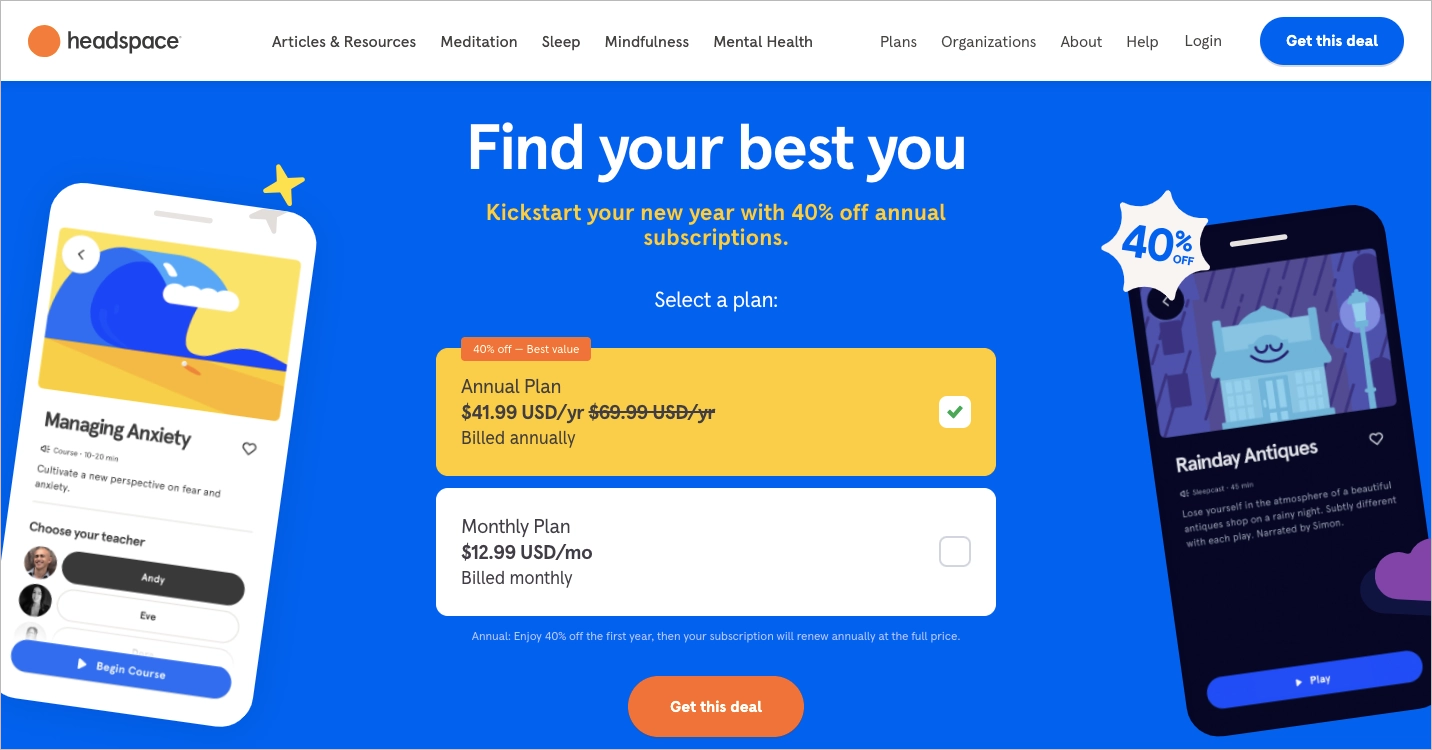
Headspace’s website uses conversion copywriting to address common pain points and aspirations of its target audience. Phrases like “Break free from stress,” “Own your mental health journey,” and “Get the sleep of your dreams” directly address potential users’ desires and challenges. This empathetic approach is reinforced with testimonials from users who share their positive experiences, adding social proof to the service.
Furthermore, the website effectively employs a holistic approach to well-being, offering solutions not just for individuals but also for families, as seen in the section “Build a happier family with Headspace.” This expands the appeal of the service to a broader audience.
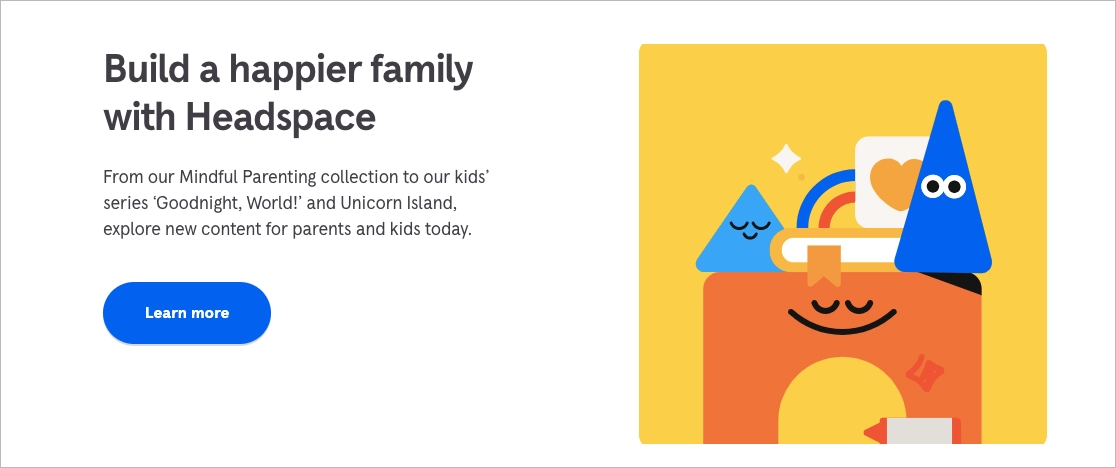
The copy is interspersed with calls-to-action like “Get this deal” and “Learn more,” strategically placed to guide visitors towards conversion. Overall, Headspace’s conversion copywriting effectively communicates the value of their service in a compelling manner.
7. Duolingo
Duolingo’s website employs persuasive copywriting that effectively combines motivational language with clear, benefit-driven messaging to engage and convert visitors. The homepage opens with a bold and inviting statement: “The free, fun, and effective way to learn a language!” This headline is powerful in its simplicity, immediately addressing three key user concerns: cost (free), experience (fun), and outcome (effective). By using direct, concise language, Duolingo sets a positive and approachable tone, making language learning seem accessible to everyone.
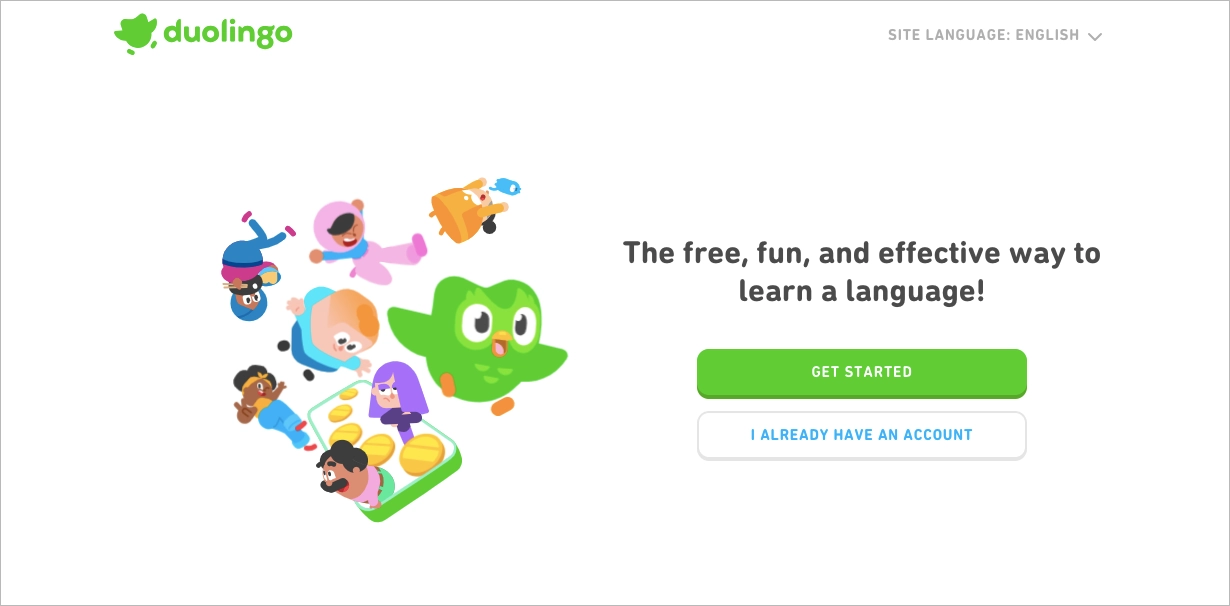
The website further reinforces its value proposition with phrases like “backed by science” and “personalized learning.” These statements not only build credibility but also appeal to users seeking a reliable and tailored learning experience. The mention of “research-backed teaching methods” and “delightful content” suggests a balance between academic rigor and enjoyable learning, catering to a broad audience.
Additionally, the copy “stay motivated” and “learn anytime, anywhere” addresses common challenges in language learning: maintaining motivation and finding time. By presenting its app as a solution to these challenges, Duolingo effectively positions itself as a convenient and user-friendly option for learners.
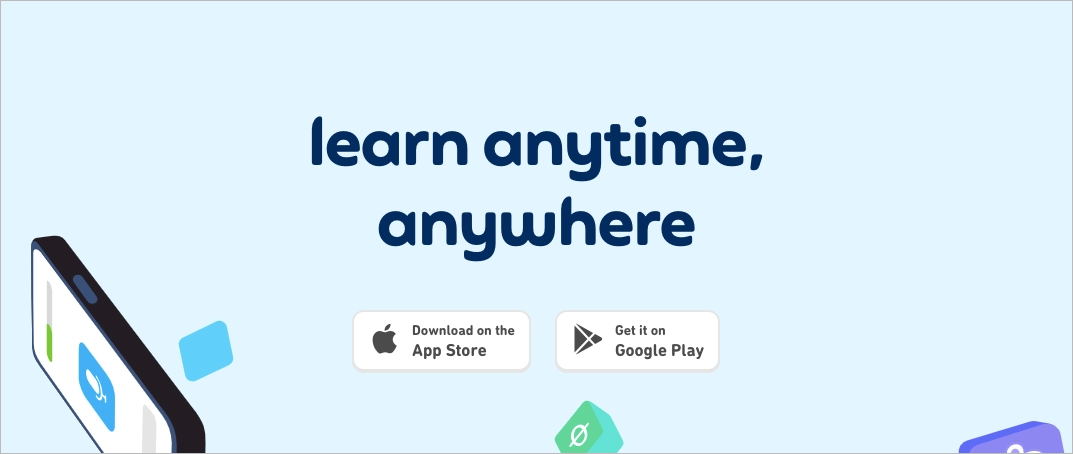
Duolingo’s copywriting excels in creating a sense of community and ongoing support. Phrases like “earn points and unlock new levels” and “game-like features, fun challenges” leverage gamification, a powerful tool in maintaining user engagement and motivation. The friendly mascot, Duo the owl, adds a personal touch, making the learning experience feel more intimate and supportive. This approach not only encourages sign-ups but also fosters long-term commitment to the app, crucial for both language learning and business success.
8. Grammarly
Grammarly’s website showcases its conversion copywriting through a blend of persuasive language and user-centric messaging. The opening statement, “You can win at work. Take our word for it,” immediately positions Grammarly as a solution to professional challenges, suggesting that success in the workplace is attainable with their tool. This is followed by a promise of “Instantly generate clear, compelling writing while maintaining your unique voice,” which directly addresses a common pain point for many users: the need for clear, effective communication without losing personal style.
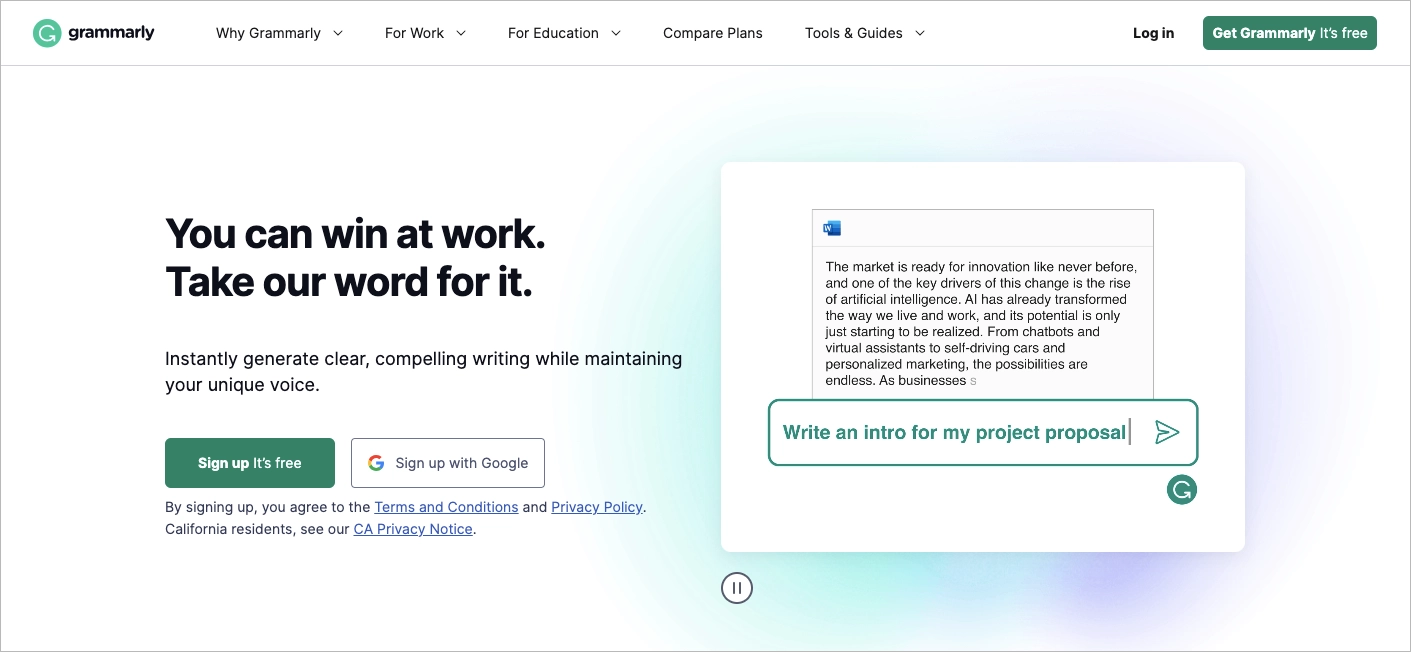
Grammarly’s copywriting is strategically designed to resonate with a broad audience, emphasizing ease of use and the immediate benefits of their AI writing assistance.
A great conversion copywriting example can be seen in Grammarly’s pitch for their Business product: “Your business relies on communication. And 70,000 teams and enterprises rely on Grammarly Business to cut the cost of routine work and ensure on-brand, quality writing.” This statement builds trust, citing a large number of existing users, and highlights the benefits of cost reduction and brand consistency. The claim of an “average ROI of 17x” effectively uses quantifiable results to persuade potential customers of Grammarly’s value.
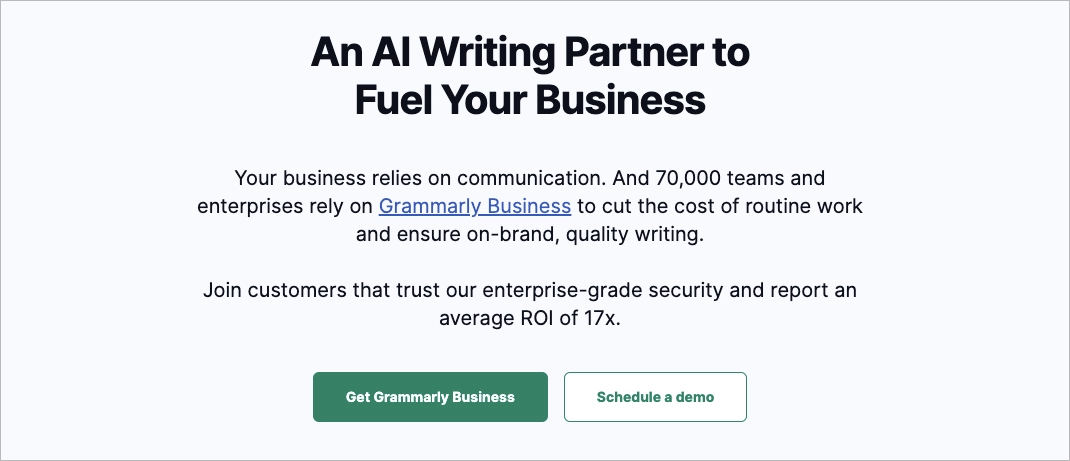
Grammarly also uses emotional appeal in their copywriting. Phrases like “Brilliant Writing Awaits” and “Discover the power of confident communication with Grammarly Free” tap into the audience’s aspirations. They promise not just a tool for better writing but an opportunity for personal and professional growth. This emotional appeal is a key component of effective CRO copywriting, as it connects with the audience on a deeper level.
9. Landingi
Landingi’s website showcases conversion copywriting that is meticulously tailored to appeal to its target demographic, which primarily includes digital marketers, business owners, and agencies. The copy on the site begins with a clear value proposition, stating it as a “No-code Landing Page Platform for data-driven Digital Marketers.” This immediately identifies the target audience and highlights key benefits such as ease of use and a focus on data-driven results.
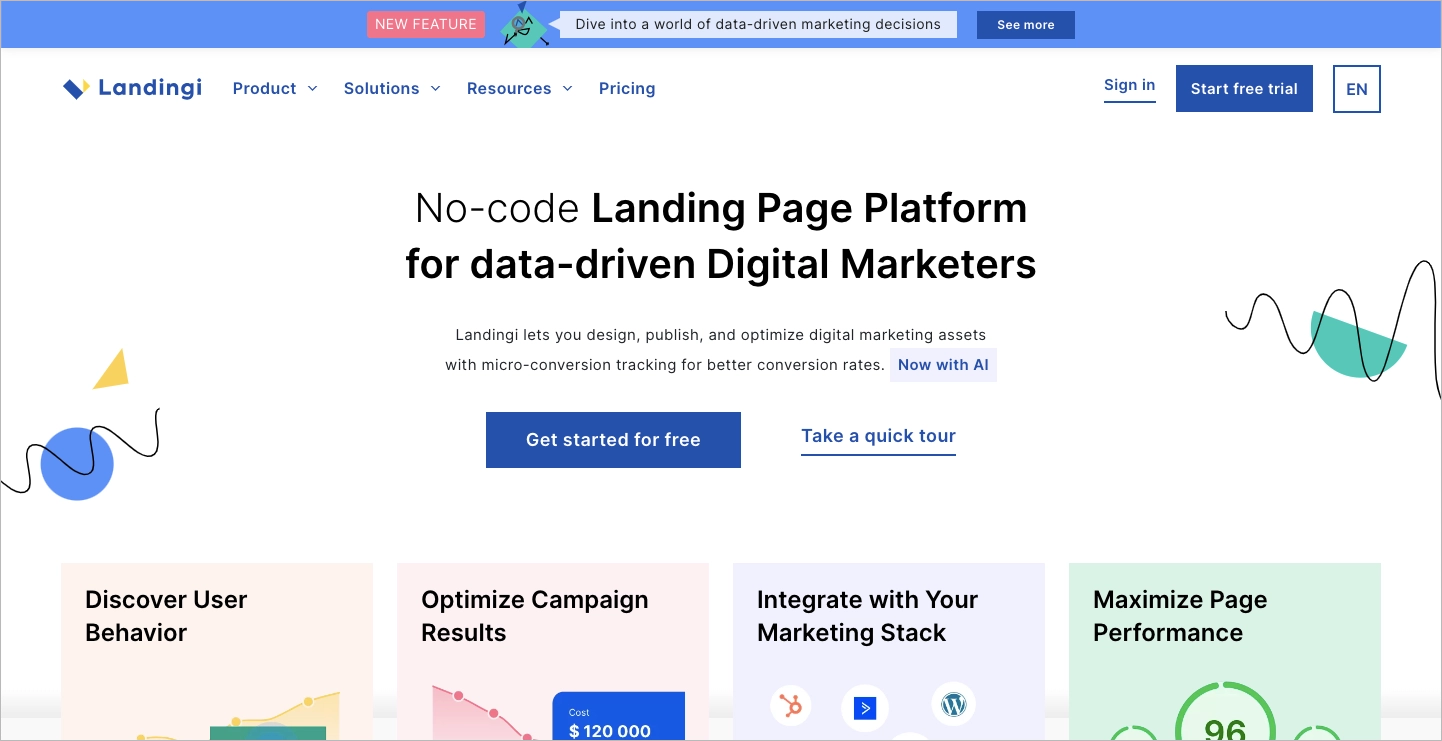
The language used throughout the site is benefits-oriented, emphasizing how Landingi allows users to design, publish, and optimize digital marketing assets with micro-conversion tracking, directly addressing the core needs of better conversion rates. Additionally, the copy uses persuasive language to enhance appeal, with phrases like “Elevate your ROI with data-driven insights, precision targeting, and higher conversions,” which resonate with marketers’ aspirations to improve ROI and targeting precision.
The website effectively communicates Landingi’s platform’s technical capabilities. It highlights features like ultra-fast page loading and high-performance scores. “Sync your data across apps and automate workflows using native and compatible integrations” addresses workflow automation and data synchronization, showcasing Landingi’s seamless integration with other tools. Furthermore, the site leverages social proof by inviting visitors to “Join leading brands that grow their business with Landingi,” suggesting that successful and reputable brands trust and use the platform, which adds to its credibility and appeal.

Landingi’s content stands out due to its innovative features and customer-focused assurances. The platform leverages AI-powered technology to position itself as a future-forward solution for landing page creation, which appeals to users seeking cutting-edge marketing tools. The copy is rounded off with a direct and clear call to action, “Get started for free,” encouraging immediate engagement with the product without financial commitment. Additionally, the mention of “All plans are risk-free, so go ahead and give us a try” effectively reduces the perceived risk of trying the service, encouraging users to sign up.
Overall, Landingi’s conversion copywriting is a well-crafted blend of persuasive language, feature highlighting, and user reassurance, all aimed at driving conversions by addressing the specific needs and desires of its target audience.
FAQ for Conversion Copywriting
Conversion copywriting, despite its importance, is a nuanced and intricate field. Let’s address some of the most common questions about high-converting texts. Answers will provide you with a comprehensive understanding of persuasive writing and help you navigate its intricacies with ease.
What is the difference between SEO and conversion copywriting?
SEO copywriting is aimed at creating content that is optimized for keywords, appealing to both search engine algorithms and human users, to increase traffic and drive conversions. On the other hand, conversion copywriting aims to comprehend the factors that drive people to take action and integrate these techniques into the copy to persuade readers.
Although the two are different, they can be successfully integrated to create content that is both compelling to the audience and favorable in search engine rankings.
What is the difference between direct response copywriting and conversion copywriting?
Both direct response and conversion copywriting aim to influence actions, but the latter focuses on the entire customer journey, including website user experience and sales funnel functionality.
Direct response copywriting revolves around the construction of content aimed at triggering an immediate response or action from the audience. It emphasizes prompting the reader to take immediate action through persuasive call-to-action statements. On the other hand, conversion copywriting considers the individual’s level of awareness and purchase readiness.
What is the difference between conversion copywriter and sales copywriter
Conversion copywriter primarily concentrates on crafting product and service descriptions, guarantees, FAQs, and testimonials using data and proven persuasion techniques to prompt readers to take a specific action, whereas sales copywriter crafts persuasive narratives that lead to a sale, typically highlighting product features and benefits on a sales page.
Conversion copywriters have the ability to extract insights from sales funnels and customer personas, utilizing data-driven approaches to test and enhance their copy for improved conversion rates.
What does convert mean in writing?
Within the realm of writing, “convert” means the act of convincing the reader to perform a particular action. This could be anything from subscribing to a newsletter to completing a purchase. The psychological approach to conversion in writing involves using persuasive writing techniques to understand the buyer’s decision-making process and influence them towards a particular action.
Conversion copywriting entails creating compelling content that effectively conveys a concise message, prompting readers to undertake a specific action aligned with the page’s content. Writing copy in this manner ensures maximum impact and engagement from the audience.
What does conversion copywriter do?
A conversion copywriter:
- Composes persuasive content with the aim of inspiring a person to perform a certain action, such as making a purchase or utilizing a service
- Is responsible for developing messaging and copy that effectively connects with the target audience
- Composes product and service descriptions, guarantees, FAQs, and testimonials
- Employs language to enhance conversion rates
Where to find best conversion copywriting courses?
Highly regarded conversion copywriting courses available online include Copywriting 2023 Persuasive Copy Writing Mastery with Dekker, CIM’s Copywriting Masterclass, and Skillshare’s Copywriting for Beginners course. Free conversion copywriting courses can be found on platforms such as YouTube, Udemy, Coursera, Class Central, Copyhackers, and Alison. If you’re just starting, we can suggest checking out the course called Conversion Copywriting for Beginners.
When selecting a conversion copywriting course, it’s crucial to clearly define your learning objectives and determine your preferred learning method.
Where to find best conversion copywriting books?
Some recommended CRO books for copywriting are “Influence” by Robert Cialdini, “The Copywriter’s Handbook” by Robert Bly, “Scientific Advertising” by Claude Hopkins, and “The Adweek Copywriting Handbook” by Joseph Sugarman.
What are the conversion copywriting principles?
Conversion copywriting principles include the following:
- Comprehending your audience
- Emphasizing benefits
- Utilizing compelling headlines
- Crafting engaging CTAs
- Maintaining conciseness
- Highlighting action
- Creating a sense of urgency
- Maintaining specificity
- Incorporating social proof
- Simplifying language
- Testing various iterations
- Adopting a conversational style
These principles are also underpinned by established models and theories, encompassing voice-of-customer data, frameworks, formulas, and proven persuasion techniques.
Over time, conversion copywriting principles have shifted focus towards creating content that motivates readers to take a specific action. These guidelines can be implemented across different forms of content by:
- Prioritizing the creation of compelling CTAs and landing pages
- Addressing reader needs and benefits in emails
- Utilizing goal-focused headlines while emphasizing benefits over features in ads
Get 111 Landing Page Examples—The Ultimate Guide for FREE
Where to find job as conversion copywriter?
Conversion copywriting jobs (also CRO copywriting jobs) are often listed on job boards such as Upwork, Freelancer.com, Facebook Group Job Boards, Writer Access, Strategically, Scripted, Indeed, Fiverr, LinkedIn, and ProBlogger Job Board. To effectively present oneself as a conversion copywriter, develop a comprehensive freelance writing portfolio, utilize a professional email address, craft a professional email signature, and seek guidance from industry experts.
The standard qualifications for pursuing a career as a CRO copywriter typically include:
- Holding a bachelor’s degree in Marketing, Communications, Journalism, or a relevant field
- Having at least 3 years of experience in the role
- Showcasing proficient writing and editing abilities
What are the different types of copywriting?
Numerous types of copywriting exist, each fulfilling a distinct purpose and demanding a unique skill set. These include the following:
- B2B Copywriting
- Brand Copywriting
- Content Marketing
- Direct Response Copywriting
- Email Copywriting
- Public Relations
- Website Copywriting
- SEO Copywriting
- Product Copywriting
- B2C Copywriting
- Ad Copywriting
- Social Copywriting
What to avoid in conversion copywriting?
Key mistakes to avoid in conversion copywriting include not having clear and compelling calls to action (CTAs), focusing too much on features rather than benefits, failing to tell a story, not creating a sense of urgency, ignoring social proof, underestimating the power of visuals, using complicated jargon, neglecting personalization, and not addressing potential objections.
By avoiding these pitfalls and keeping the above-mentioned best practices in mind, you can help ensure that your conversion copywriting efforts are as effective as possible.
Implement Conversion Copywriting on Your Landing Pages
The essence of conversion copywriting lies in its ability to resonate deeply with the target audience, addressing their specific needs and pain points. This approach not only fosters a sense of connection and trust but also guides potential customers through the decision-making process, ultimately leading to increased conversions.
Landingi, with its focus on data-driven insights and user-friendly design, empowers marketers to apply these principles with precision and creativity. By leveraging tools like Landingi, businesses can transform their landing pages into powerful conversion engines, ensuring that every element of their copy is optimized for maximum impact.
The integration of conversion copywriting techniques with Landingi Builder represents a strategic approach to digital marketing, one that promises to elevate the effectiveness of online campaigns and drive business growth.

